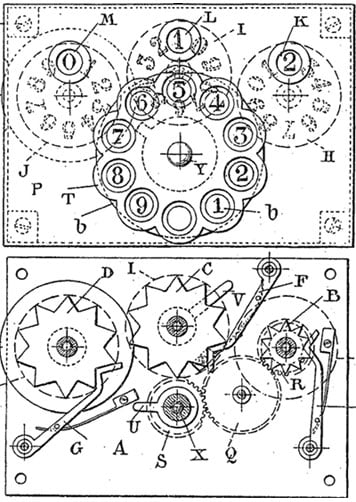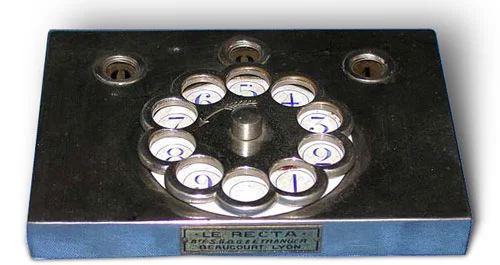In 1642, Blaise Pascal invented the first mechanical calculator. Inventors continued to invent new calculators and adding machines. Some were destined to remain on paper only, never to be manufactured.
In 1820, Charles De Colmar invented the arithometer, a mechanical device that was capable of performing addition, subtraction, multiplication, and division up to six-digit results. This mechanical calculator was manufactured by Devrine, a Parisian mécanicien and clockmaker, who produced approximately 1,500 of these devices between 1822 and 1878. It was the first commercially produced calculator and, astoundingly, was in use until World War I.
In 1881, French inventor Hugues Beaucort patented a mechanical adding and subtracting machine that looked totally unlike De Colmar’s. While the device was never produced under the original patent, De Colmar’s son Edmond re-patented it in Switzerland and Great Britain. While there is no indication that it was the commercial success that De Colmar’s arithometer was, it was manufactured and sold during the 1910s.
Hugues and Edmond Beaucourt
Hugues Beaucourt was born in 1845 and was the son of Hippolyte-César Beaucourt. Hippolyte was a very well-known craftsman who made organs. His father lived from 1822 to 1888 and was from Lyon, France. Hugues worked with and for his father for many years, up until 1914, a stint of 45 years. He took over the family-owned business, but he would find time to create inventions, including a device that functions as a horn for automobiles.
The patent for the automobile sounding device listed a description “The arrangement or adaptation of acoustic devices for providing signals to the outside of the vehicle.” Having the background with his father and the experience in the organ making industry, Hugues Beaucourt surely used this for the inspiration of this invention.
More importantly for the adding and calculating world, he invented and patented his adding and subtracting machine on February 18, 1881 (French patent 141208). It was named appareil pour calculer. The unique adder utilized keys that looked a good deal an old rotary telephone with a circular pattern of numbers.
Hugues Beaucourt’s original adding machine seems to never have been put into production, despite having a patent. Perhaps he was too involved with the family organ-making business to put much time into developing the device. However, Hugues’s son Edmond (born in 1878) would take up the mantel thirty years later and re-patent the adding and subtracting machine about five years before his father died. For this device it held the Swiss patent CH62168 from 1912 for Machine à calculer portative. Edmond also had the Great Britain patent GB191217401 in 1913 for the Improved Adding and Subtracting Apparatus). The adding and subtracting machine was manufactured and sold under the name Le Recta in 1910s (see the lower photo).

It was a fairly plain-looking metal column adder with dimensions (LxWxH): 12.5 x 8.5 x 1.5 cm and weight: 524 g.
The construction of the device (see the lower patent drawing) is simple and reliable, although the intriguing dialing input mechanism must have been rather slow (but also not prone to the common problem of the exceeding momentum, that could be given in an adding action).

The image featured at the top of this post is ©Unknown author / public domain
